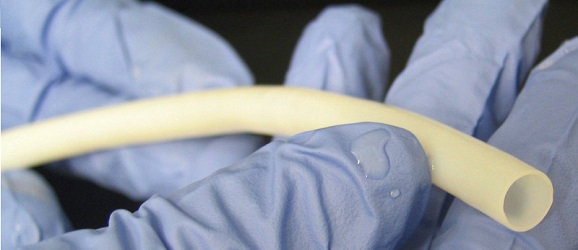First U.S. Synthetic Blood Vessel Successfully Implanted In Patient
This article is more than 2 years old
 These are strange days indeed when news about the successful development of synthetic body parts occurs on a regular basis. I’d like to cut off my hand, grow another one, and then pat the entire medical field on the back for never letting adversity stand in the way of some truly amazing advancements.
These are strange days indeed when news about the successful development of synthetic body parts occurs on a regular basis. I’d like to cut off my hand, grow another one, and then pat the entire medical field on the back for never letting adversity stand in the way of some truly amazing advancements.
The first U.S. clinical trial involving the implantation of a bioengineered blood vessel was performed on June 5, 2013, and the organ was implanted in a 62-year-old Danville, Virginia man with end-stage renal failure. The surgery was the result of a 15-year collaboration between Jeffrey H. Lawson M.D., PhD — a vascular surgeon and vascular biologist at Duke Medicine — and Laura Niklason, M.D. PhD — co-founder of Duke offshoot company Humacyte and former Duke faculty member, now at Yale. Over the years, the treatment was successfully performed on animals, and a 20-patient clinical trial was recently approved by the FDA. It will focus on implanting vessels in easy-to-access areas of the arms of hemodialysis patients, which includes 350,000 U.S. citizens.
“We hope this sets the groundwork for how these things can be grown, how they can incorporate into the host, and how they can avoid being rejected immunologically,” said Lawson. “A blood vessel is really an organ — it’s complex tissue. We start with this, and one day we may be able to engineer a liver or a kidney or an eye.”
The team uses a biodegradable and malleable mesh that is shaped as a blood vessel that fits the patient, injected with muscle cells, and eventually dissolves once the cells become enriched with nutrients and amino acids. The nutrients are pumped through the vessel to mimic a heartbeat, so it can develop similar properties to body’s natural blood vessels. I wonder if it’s possible to set it to play the Conga anytime an attractive person of the opposite sex walks by, but perhaps only synthetic cartoon-wolf blood vessels can do that.
Human tissue donations are used to create the tubing, and all of the cellular properties are washed away with a special solution, which means patients wouldn’t have to worry about their body rejecting the vessel. That’s a lot of pros without a lot of (stated) cons. What’s more, because the patients’ biological identity isn’t a factor, they don’t need to be made to order, so stockpiling will be possible. Let’s get some of that smart skin put on top of it, too, to tell us how things are going.
“At the end of the process, we have a non-living, immunologically silent graft that can be stored on the shelf and used in patients whenever they need it,” Niklason said. “Unlike other synthetic replacements made of Teflon or Dacron, which tend to be stiff, our blood vessels mechanically match the arteries and veins they are being sewn to. We think this is an advantage.”
So there you have it, folks. Science has gone all amazing again. Should this trial be as successful as it seems to be initially, the teams plans on immediately developing a similar tubing to use in heart bypass surgeries, nearly 400,000 of which are performed annually in the U.S. alone. Now, the old boy may be barely breathing. But the heart of rock ‘n’ roll is still beating.











